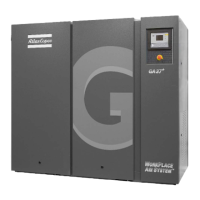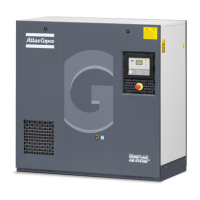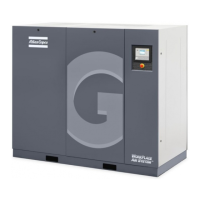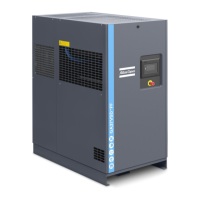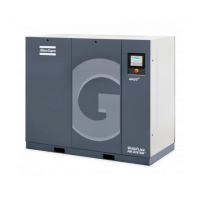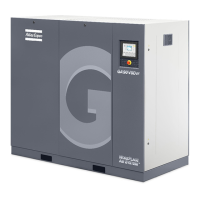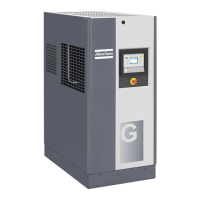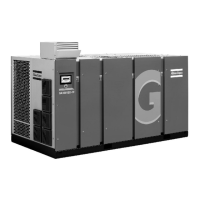Do you have a question about the Atlas Copco GA 30+ and is the answer not in the manual?
Explains the meaning of various safety symbols used in the manual.
Outlines essential safety rules for operation, handling, and general use.
Details safety measures required specifically for the installation process.
Specifies safety guidelines to be followed during the compressor's operation.
Provides safety instructions for performing maintenance and repair work.
Provides an overview of the GA 30+, GA 37, and GA 45 compressor models.
Explains the internal flow paths for air and oil within the compressor system.
Details the components and function of the compressor's cooling system.
Describes the system responsible for collecting and removing condensate.
Explains how the compressor regulates its operation based on demand.
Outlines the electrical components and their layout within the compressor.
Details the function and operation of the integrated air dryer.
Introduces the controller and its core functions like monitoring and protection.
Lists and explains the meaning of icons displayed on the controller screen.
Describes the primary display screen showing compressor status and pressure.
Details warnings that precede a compressor shutdown.
Explains the conditions that cause the compressor to shut down.
Notifies the operator about required service actions based on timers.
Guides on navigating through the various screens of the controller.
Instructions on how to display temperature readings on the controller.
How to access and view the total running hours of the compressor.
Procedure to check the number of motor start cycles.
How to view the total hours the compressor has operated under load.
Guides on viewing and resetting the service timer intervals.
How to choose the control mode: local, remote, or network (LAN).
Instructions for configuring the controller's network settings.
How to adjust the load and unload pressure settings for optimal operation.
Procedure to enable the compressor's automatic restart function.
How to configure various protection parameters for the compressor.
Guides on performing diagnostic tests on the controller and display.
Instructions for accessing and using the controller's web server interface.
Overview of the graphic controller's functions and capabilities.
Details the physical layout and function of the controller's buttons and indicators.
Explains the meaning of all icons displayed on the graphic controller.
Describes the different views and information presented on the main screen.
How to navigate through the controller's menu structure.
How to view and select input signals for display or charting.
How to view the current status of the compressor's outputs.
How to access and view various counter values like running hours and motor starts.
How to select the desired control mode (local, remote, or network).
Guides on managing service plans, intervals, and history.
How to program and select pressure bands for compressor operation.
How to view records of past shutdowns and emergency stops.
How to adjust general settings such as language, date, and time format.
How to program time-based commands for compressor operation.
Instructions for performing display and safety valve diagnostic tests.
How to activate and manage user passwords for security.
Guides on connecting to and using the controller's web server interface.
Overview of the components that make up the energy recovery system.
Explains different system configurations for energy recovery.
Describes how the energy recovery system functions during compressor operation.
Procedures for maintaining the energy recovery system components.
Presents data and typical examples of energy recovery performance.
Specifies the necessary quality requirements for cooling water.
Provides detailed dimensional data and drawings for the compressor unit.
Offers guidelines and recommendations for compressor installation.
Details the wiring diagrams and procedures for electrical connections.
Explains the meaning of various pictographs used in the manual.
Step-by-step guide for the first-time startup of the compressor.
Pre-operation checks and preparations required before starting the compressor.
Procedure for safely starting the compressor.
Guidelines for safe and efficient operation of the compressor.
Instructions on how to read and interpret the compressor's control panel display.
Procedure for safely stopping the compressor.
Steps for safely decommissioning and taking the compressor out of service.
Details the scheduled maintenance tasks and their intervals.
Information on recommended oils and their specifications for the compressor.
Maintenance recommendations for the electric drive motor.
Instructions for inspecting, replacing, and resetting the air filter.
Procedure for changing the compressor oil and oil filter.
Guidelines for cleaning and maintaining the compressor coolers.
Information on the operation, testing, and replacement of safety valves.
Specific maintenance procedures for the air dryer unit.
Information on available service kits for maintenance tasks.
Procedures for storing the compressor unit after installation.
Guidelines for the safe and environmentally friendly disposal of used materials.
Explains the readings and information displayed on the controller.
Provides tables for electric cable sizing and fuse selection.
Details the settings for motor and fan overload protection.
Specifies the factory-adjusted settings for dryer control devices.
Defines the reference conditions under which technical data is valid.
Presents detailed technical specifications for the compressor models.
Provides technical specifications for the controller unit.
Explains the meaning of various safety symbols used in the manual.
Outlines essential safety rules for operation, handling, and general use.
Details safety measures required specifically for the installation process.
Specifies safety guidelines to be followed during the compressor's operation.
Provides safety instructions for performing maintenance and repair work.
Provides an overview of the GA 30+, GA 37, and GA 45 compressor models.
Explains the internal flow paths for air and oil within the compressor system.
Details the components and function of the compressor's cooling system.
Describes the system responsible for collecting and removing condensate.
Explains how the compressor regulates its operation based on demand.
Outlines the electrical components and their layout within the compressor.
Details the function and operation of the integrated air dryer.
Introduces the controller and its core functions like monitoring and protection.
Lists and explains the meaning of icons displayed on the controller screen.
Describes the primary display screen showing compressor status and pressure.
Details warnings that precede a compressor shutdown.
Explains the conditions that cause the compressor to shut down.
Notifies the operator about required service actions based on timers.
Guides on navigating through the various screens of the controller.
Instructions on how to display temperature readings on the controller.
How to access and view the total running hours of the compressor.
Procedure to check the number of motor start cycles.
How to view the total hours the compressor has operated under load.
Guides on viewing and resetting the service timer intervals.
How to choose the control mode: local, remote, or network (LAN).
Instructions for configuring the controller's network settings.
How to adjust the load and unload pressure settings for optimal operation.
Procedure to enable the compressor's automatic restart function.
How to configure various protection parameters for the compressor.
Guides on performing diagnostic tests on the controller and display.
Instructions for accessing and using the controller's web server interface.
Overview of the graphic controller's functions and capabilities.
Details the physical layout and function of the controller's buttons and indicators.
Explains the meaning of all icons displayed on the graphic controller.
Describes the different views and information presented on the main screen.
How to navigate through the controller's menu structure.
How to view and select input signals for display or charting.
How to view the current status of the compressor's outputs.
How to access and view various counter values like running hours and motor starts.
How to select the desired control mode (local, remote, or network).
Guides on managing service plans, intervals, and history.
How to program and select pressure bands for compressor operation.
How to view records of past shutdowns and emergency stops.
How to adjust general settings such as language, date, and time format.
How to program time-based commands for compressor operation.
Instructions for performing display and safety valve diagnostic tests.
How to activate and manage user passwords for security.
Guides on connecting to and using the controller's web server interface.
Overview of the components that make up the energy recovery system.
Explains different system configurations for energy recovery.
Describes how the energy recovery system functions during compressor operation.
Procedures for maintaining the energy recovery system components.
Presents data and typical examples of energy recovery performance.
Specifies the necessary quality requirements for cooling water.
Provides detailed dimensional data and drawings for the compressor unit.
Offers guidelines and recommendations for compressor installation.
Details the wiring diagrams and procedures for electrical connections.
Explains the meaning of various pictographs used in the manual.
Step-by-step guide for the first-time startup of the compressor.
Pre-operation checks and preparations required before starting the compressor.
Procedure for safely starting the compressor.
Guidelines for safe and efficient operation of the compressor.
Instructions on how to read and interpret the compressor's control panel display.
Procedure for safely stopping the compressor.
Steps for safely decommissioning and taking the compressor out of service.
Details the scheduled maintenance tasks and their intervals.
Information on recommended oils and their specifications for the compressor.
Maintenance recommendations for the electric drive motor.
Instructions for inspecting, replacing, and resetting the air filter.
Procedure for changing the compressor oil and oil filter.
Guidelines for cleaning and maintaining the compressor coolers.
Information on the operation, testing, and replacement of safety valves.
Specific maintenance procedures for the air dryer unit.
Information on available service kits for maintenance tasks.
Procedures for storing the compressor unit after installation.
Guidelines for the safe and environmentally friendly disposal of used materials.
Explains the readings and information displayed on the controller.
Provides tables for electric cable sizing and fuse selection.
Details the settings for motor and fan overload protection.
Specifies the factory-adjusted settings for dryer control devices.
Defines the reference conditions under which technical data is valid.
Presents detailed technical specifications for the compressor models.
Provides technical specifications for the controller unit.
| Model | GA 30+ |
|---|---|
| Category | Air Compressor |
| Power | 30 kW |
| Working Pressure | 7.5-13 bar |
| Cooling System | Air-cooled |
| Noise Level | 69 dB(A) |
| FAD | 5.2 m³/min |

